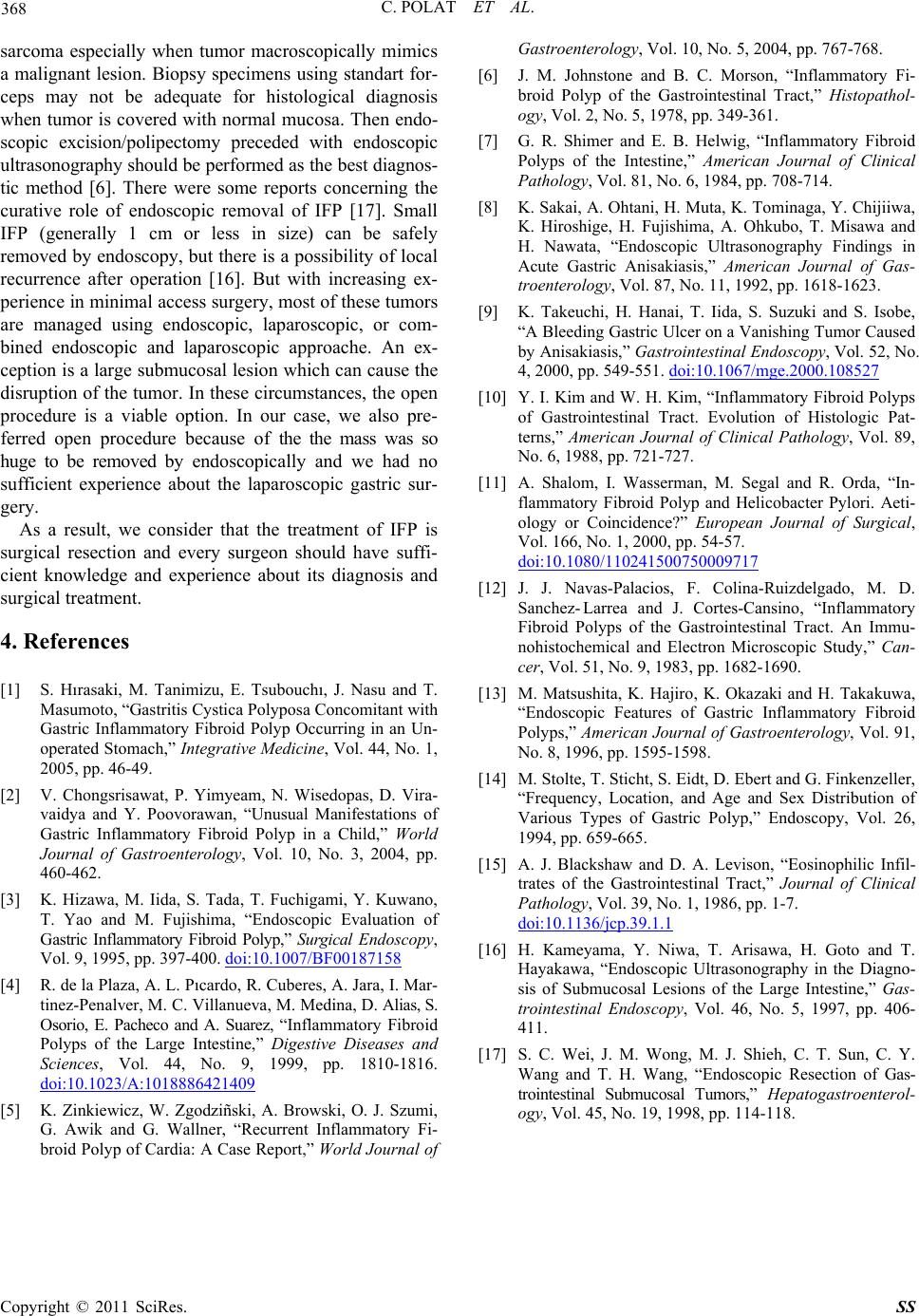
C. POLAT ET AL.
Copyright © 2011 SciRes. SS
368
sarcoma especially when tumor macroscopically mimics
a malignant lesion. Biopsy specimens using standart for-
ceps may not be adequate for histological diagnosis
when tumor is covered with normal mucosa. Then endo-
scopic excision/polipectomy preceded with endoscopic
ultrasonography should be performed as the best diagnos-
tic method [6]. There were some reports concerning the
curative role of endoscopic removal of IFP [17]. Small
IFP (generally 1 cm or less in size) can be safely
removed by endoscopy, but there is a possibility of local
recurrence after operation [16]. But with increasing ex-
perience in minimal access surgery, most of these tumors
are managed using endoscopic, laparoscopic, or com-
bined endoscopic and laparoscopic approache. An ex-
ception is a large submucosal lesion which can cause the
disruption of the tumor. In these circumstances, the open
procedure is a viable option. In our case, we also pre-
ferred open procedure because of the the mass was so
huge to be removed by endoscopically and we had no
sufficient experience about the laparoscopic gastric sur-
gery.
As a result, we consider that the treatment of IFP is
surgical resection and every surgeon should have suffi-
cient knowledge and experience about its diagnosis and
surgical treatment.
4. References
[1] S. Hırasaki, M. Tanimizu, E. Tsubouchı, J. Nasu and T.
Masumoto, “Gastritis Cystica Polyposa Concomitant with
Gastric Inflammatory Fibroid Polyp Occurring in an Un-
operated Stomach,” Integrative Medicine, Vol. 44, No. 1,
2005, pp. 46-49.
[2] V. Chongsrisawat, P. Yimyeam, N. Wisedopas, D. Vira-
vaidya and Y. Poovorawan, “Unusual Manifestations of
Gastric Inflammatory Fibroid Polyp in a Child,” World
Journal of Gastroenterology, Vol. 10, No. 3, 2004, pp.
460-462.
[3] K. Hizawa, M. Iida, S. Tada, T. Fuchigami, Y. Kuwano,
T. Yao and M. Fujishima, “Endoscopic Evaluation of
Gastric Inflammatory Fibroid Polyp,” Surgical Endoscopy,
Vol. 9, 1995, pp. 397-400. doi:10.1007/BF00187158
[4] R. de la Plaza, A. L. Pıcardo, R. Cuberes, A. Jara, I. Mar-
tinez-Penalver, M. C. Villanueva, M. Medina, D. Alias, S.
Osorio, E. Pacheco and A. Suarez, “Inflammatory Fibroid
Polyps of the Large Intestine,” Digestive Diseases and
Sciences, Vol. 44, No. 9, 1999, pp. 1810-1816.
doi:10.1023/A:1018886421409
[5] K. Zinkiewicz, W. Zgodziñski, A. Browski, O. J. Szumi,
G. Awik and G. Wallner, “Recurrent Inflammatory Fi-
broid Polyp of Cardia: A Case Report,” World Journal of
Gastroenterology, Vol. 10, No. 5, 2004, pp. 767-768.
[6] J. M. Johnstone and B. C. Morson, “Inflammatory Fi-
broid Polyp of the Gastrointestinal Tract,” Histopathol-
ogy, Vol. 2, No. 5, 1978, pp. 349-361.
[7] G. R. Shimer and E. B. Helwig, “Inflammatory Fibroid
Polyps of the Intestine,” American Journal of Clinical
Pathology, Vol. 81, No. 6, 1984, pp. 708-714.
[8] K. Sakai, A. Ohtani, H. Muta, K. Tominaga, Y. Chijiiwa,
K. Hiroshige, H. Fujishima, A. Ohkubo, T. Misawa and
H. Nawata, “Endoscopic Ultrasonography Findings in
Acute Gastric Anisakiasis,” American Journal of Gas-
troenterology, Vol. 87, No. 11, 1992, pp. 1618-1623.
[9] K. Takeuchi, H. Hanai, T. Iida, S. Suzuki and S. Isobe,
“A Bleeding Gastric Ulcer on a Vanishing Tumor Caused
by Anisakia sis,” Gastrointestinal Endoscopy, Vol. 52, No.
4, 2000, pp. 549-551. doi:10.1067/mge.2000.108527
[10] Y. I. Kim and W. H. Kim, “Inflammatory Fi broid Polyps
of Gastrointestinal Tract. Evolution of Histologic Pat-
terns,” American Journal of Clinical Pathology, Vol. 89,
No. 6, 1988, pp. 721-727.
[11] A. Shalom, I. Wasserman, M. Segal and R. Orda, “In-
flammatory Fibroid Polyp and Helicobacter Pylori. Aeti-
ology or Coincidence?” European Journal of Surgical,
Vol. 166, No. 1, 2000, pp. 54-57.
doi:10.1080/110241500750009717
[12] J. J. Navas-Palacios, F. Colina-Ruizdelgado, M. D.
Sanchez- Larrea and J. Cortes-Cansino, “Inflammatory
Fibroid Polyps of the Gastrointestinal Tract. An Immu-
nohistochemical and Electron Microscopic Study,” Can-
cer, Vol. 51, No. 9, 1983, pp. 1682-1690.
[13] M. Matsushita, K. Hajiro, K. Okazaki and H. Takakuwa,
“Endoscopic Features of Gastric Inflammatory Fibroid
Polyps,” American Journal of Gastroenterology, Vol. 91,
No. 8, 1996, pp. 1595-1598.
[14] M. Stolte, T. Sticht, S. Eidt, D. Ebert and G. Finkenzeller,
“Frequency, Location, and Age and Sex Distribution of
Various Types of Gastric Polyp,” Endoscopy, Vol. 26,
1994, pp. 659-665.
[15] A. J. Blackshaw and D. A. Levison, “Eosinophilic Infil-
trates of the Gastrointestinal Tract,” Journal of Clinical
Pathology, Vol. 39, No. 1, 1986, pp. 1-7.
doi:10.1136/jcp.39.1.1
[16] H. Kameyama, Y. Niwa, T. Arisawa, H. Goto and T.
Hayakawa, “Endoscopic Ultrasonography in the Diagno-
sis of Submucosal Lesions of the Large Intestine,” Gas-
trointestinal Endoscopy, Vol. 46, No. 5, 1997, pp. 406-
411.
[17] S. C. Wei, J. M. Wong, M. J. Shieh, C. T. Sun, C. Y.
Wang and T. H. Wang, “Endoscopic Resection of Gas-
trointestinal Submucosal Tumors,” Hepatogastroenterol-
ogy, Vol. 45, No. 19, 1998, pp. 114-118.